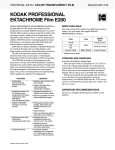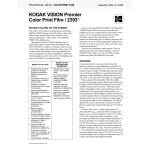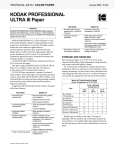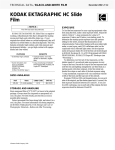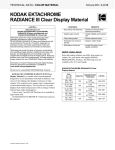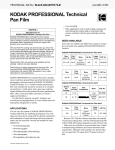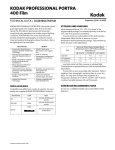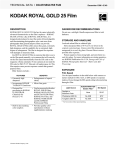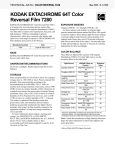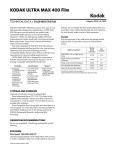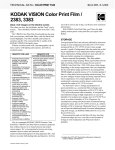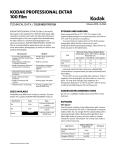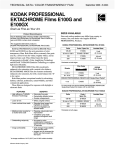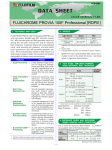Download Kodak Professional Elite Chrome 200
Transcript
April 2005 • E-148E TECHNICAL DATA / COLOR REVERSAL FILM KODAK PROFESSIONAL ELITE Chrome 200 Film This medium-speed, daylight-balanced 200-speed color reversal film is designed for KODAK Chemicals, Process E-6. The film offers moderate contrast, along with excellent color and image structure similar to 100-speed daylight slide films. It is ideal for general outdoor or daylight picture-taking under moderate- to low-light conditions. ELITE Chrome 200 Film also features KODAK T-GRAIN Emulsion technology for extremely fine grain and very high sharpness, plus improvements in reciprocity and manufacturing consistency. The film is designed for exposure with daylight or electronic flash. You can also expose it with tungsten illumination (3200 K) or photolamps (3400 K) using filters. Use ELITE Chrome 200 Film to produce color transparencies (slides) for projection. You can make duplicate transparencies by direct printing. To make color prints, you can print transparencies onto color reversal paper. Or make internegatives for printing onto color negative paper. You can also scan transparencies for digital printing and for Photo CD applications. FEATURES BENEFITS Color Saturation: • Enhanced colors while maintaining natural-looking skin tones • Pleasing colors • Beautiful skin-tone reproduction • Contrast of an EI 100-speed color reversal film (lower contrast than other high-speed color reversal films) • Improved reproduction of highlight and shadow details • More tone gradation for more natural-appearing images Image Structure Technology: • KODAK T-GRAIN® Emulsions in all color records • Finest grain structure of any daylight, high-speed color reversal film on the market (>100 speed) • High sharpness Advanced Color Technology: • Solid-Particle Filter Dye for • Produces purer colors and wavelength-selective, enhanced sharpness blue- and green-light • Provides broader range of protection blue-light capture • Patented Stable Super Active Scavengers (SSAS) • New spectral sensitizing dyes Exposure Reliability: • Superb reciprocity • Consistent results in exposures from 10 seconds to 1/10,000 second with no exposure or filter corrections • Improved manufacturing process • Excellent roll-to-roll consistency Process Reliability: • Designed for Process E-6 chemicals ©Eastman Kodak Company, 2005 • Process with other films in Process E-6 without equipment or process modifications MANUFACTURING UNIFORMITY Daylight Similar to ELITE Chrome 100 and 400 Films, the 200 film takes full advantage of Kodak’s new state-of-the-art manufacturing facility in Rochester, New York. The result is a film with excellent roll-to-roll consistency and accurate 200 speed. Use the exposures in the table below for average frontlit subjects from 2 hours after sunrise to 2 hours before sunset. STORAGE AND HANDLING Load and unload film in subdued light. Store unexposed film in a refrigerator at 55°F (13°C) or lower in the original sealed package. To avoid moisture condensation on film that has been refrigerated, allow the film to warm up to room temperature before opening the package. Process film as soon as possible after exposure. Protect transparencies from strong light, and store them in a cool, dry place. For more information, see KODAK Publication No. E-30, Storage and Care of KODAK Photographic Materials—Before and After Processing. SIZES AVAILABLE Sizes and catalog numbers may differ from country to country. See your dealer who supplies Kodak products. Shutter Speed Lens (second) Opening Lighting Conditions Bright/Hazy Sun on Sand or Snow 1/250 ƒ/22 Bright/Hazy Sun, Distinct Shadows 1/250 ƒ/16* Weak, Hazy Sun, Soft Shadows 1/250 ƒ/11 Cloudy Bright, No Shadows 1/250 ƒ/8 1/250 ƒ/5.6 Heavy Overcast or Open Shade† * Use ƒ/8 for backlit close-up subjects. † Subjects shaded from sun but lit by large area of clear sky. Electronic Flash Use the appropriate guide number in the following table as a starting point for your equipment. First select the unit output closest to the number given by your flash manufacturer. Then find the guide number for feet or metres. To determine the lens opening, divide the guide number by the flash-to-subject distance. If transparencies are consistently too thin (overexposed), use a higher guide number; if they are too dense (underexposed), use a lower number. Guide Number Unit Output (BCPS*) Distance in Feet Distance in Metres 350 60 18 500 70 21 700 85 26 1000 100 30 1400 120 36 2000 140 42 2800 170 50 4000 200 60 EXPOSURE 5600 240 70 Exposure Index Numbers 8000 280 85 Rolls Code Base 135-24 135-24 (carded) ED 5-mil acetate 135-36 DARKROOM RECOMMENDATIONS Do not use a safelight. Handle unprocessed film in total darkness. Use the exposure index numbers below with cameras or light meters marked for ISO or ASA speeds or exposure indexes. Do not change the film-speed setting when metering through a filter. Metering through filters may affect meter accuracy; see your meter or camera manual for specific information. For critical work, make a series of test exposures. Light Source Daylight or Electronic Flash Tungsten (3200 K) 2 * BCPS=beam candlepower seconds. KODAK WRATTEN Exposure Gelatin Filter Index None 200 No. 80A 50 KODAK PROFESSIONAL ELITE Chrome 200 Film • E-148E Fluorescent and High-Intensity Discharge Lamps Use the color-compensating filters and exposure adjustments below as starting points to expose this film under fluorescent or high-intensity discharge lamps. For critical applications, make a series of test exposures under your actual conditions. To avoid the brightness and color variations that occur during a single alternating-current cycle, use exposure times of 1/60 second or longer with fluorescent lamps; with high-intensity discharge lamps, use 1/125 second or longer. Adjustments for Long and Short Exposures No filter correction or exposure compensation is required for exposures from 1/10,000 to 10 seconds. Note: This information applies only when exposing the film to daylight. The data are based on average emulsions rounded to the nearest 1/2 stop and assume normal, recommended processing. Use the data only as a guide. For critical applications, make tests under your conditions. PROCESSING Type of Fluorescent Lamp KODAK Color Compensating Filters Exposure Adjustment Daylight 50R +1 stop White 40M +2⁄3 stop Warm White 20C + 40M +1 stop Warm White Deluxe 30B + 30C +1 1⁄3 stops Cool White 40M + 10Y +1 stop Cool White Deluxe 20C + 10M +2⁄3 stop Note: When you do not know the type of fluorescent lamps, try a 30M filter and increase exposure by 2/3 stop; color rendition will probably be less than optimum. Process ELITE Chrome 200 Film in KODAK Chemicals, Process E-6. RETOUCHING TRANSPARENCIES Use KODAK E-6 Transparency Retouching Dyes. You can retouch only the emulsion side of this film. For information on retouching equipment, supplies, and techniques, see KODAK Publication No. E-68, Retouching Transparencies on KODAK EKTACHROME Film. PRINTING TRANSPARENCIES High-Intensity Discharge Lamp KODAK Color Exposure Compensating Filters Adjustment General Electric Lucalox* 80B + 20C +2 1⁄3 stops General Electric Multi-Vapor 20R + 20M +2⁄3 stop Deluxe White Mercury 30R + 30M +1 1⁄3 stops 70R +1 1⁄3 stops Clear Mercury You can make color prints or enlargements photographically by making an internegative and printing on Kodak color negative paper. You can also make prints and enlargements with a KODAK Picture Maker. This self-serve picture kiosk makes prints from wallet to 8 x 10-inches, and allows you to remove red-eye, add text and borders, and make calendars. See your photo dealer for availability in your area. * This is a high-pressure sodium-vapor lamp. The information in the table may not apply to other manufacturers’ sodium-vapor lamps because of differences in spectral characteristics. Note: Consult the manufacturer of high-intensity lamps for ozone ventilation requirements and safety information on ultraviolet radiation. Some primary color filters were used in the previous tables to reduce the number of filters and keep the exposure adjustment to a minimum. Red filters were substituted for equivalent filtration in magenta and yellow. Blue filters were substituted for equivalent filtration in cyan and magenta. KODAK PROFESSIONAL ELITE Chrome 200 Film • E-148E 3 Modulation-Transfer Curves SCANNING TRANSPARENCIES IMAGE STRUCTURE Diffuse rms Granularity* 12 *Read at a gross diffuse visual density of 1.0, using a 48-micrometre aperture, 12X magnification. 200 100 70 50 B RESPONSE (%) 30 20 G 10 R 7 5 3 Exposure: Daylight Process: E-6 2 1 1 3 4 5 10 20 50 100 200 600 F009_0061AC Spectral-Sensitivity Curves 2.0 1.0 YellowForming Layer CyanForming Layer MagentaForming Layer 0.0 1.0 Effective Exposure: 0.1 second Process: E-6 Densitometry: 1.0 Density: E.N.D. 2.0 250 Characteristic Curves 2 SPATIAL FREQUENCY (cycles/mm) LOG SENSITIVITY * You can easily scan ELITE Chrome 200 Film with a variety of linear-array-CCD, area-array-CCD, and PMT film scanners. You can scan slides on desk-top scanners as well as high-end drum scanners. Because no standards exist to define the colored filter sets that film scanners use to capture the red, green, and blue information of the film image, each manufacturer’s scanner has its own characteristic output. The output depends on the scanner’s sensitivity to the dyes in the film. This sensitivity is determined by the spectral distribution of the colored filter sets and/or the spectral sensitivity of the charge-coupled-device (CCD). In addition to these spectral specifications, scanner output depends on the look-up tables or matrices that the scanner uses to output information for CRT monitors, transmission, etc. These tables or matrices are part of either “plug-in” programs used with specific software packages designed for image manipulation, updateable ROMs included with the equipment, or fixed algorithms for calibrating and balancing. The generic “color slide film” setting available with scanner software is only a starting point. You can adjust the final color balance and the scene-dependent contrast and brightness of an image by using the scanner’s controls during pre-scan, or by using an image-manipulation software program or workstation after acquisition. Some scanners allow you to use “plug-in” programs to customize scanner setups. 300 350 400 450 500 550 600 650 700 750 WAVELENGTH (nm) 2 *Sensitivity = reciprocal of exposure (erg/cm ) required to produce specified density 4.0 B G F009_0060AC NOTICE: The sensitometric curves and data in this publication represent product tested under the conditions of exposure and processing specified. They are representative of production coatings, and therefore do not apply directly to a particular box or roll of photographic material. They do not represent standards or specifications that must be met by Eastman Kodak Company. The company reserves the right to change and improve product characteristics at any time. R 3.0 DENSITY Exposure: Daylight 1/100 second Process: E-6 Densitometry: Status A 2.0 1.0 0.0 3.0 2.0 1.0 0.0 LOG EXPOSURE (lux-seconds) 4 1.0 F009_0059AC KODAK PROFESSIONAL ELITE Chrome 200 Film • E-148E MORE INFORMATION Spectral-Dye-Density Curves DIFFUSE SPECTRAL DENSITY 1.5 Kodak has many publications to assist you with information on Kodak products, equipment, and materials. The following publication are available from dealers who sell Kodak products, or you can contact Kodak in your country for more information. Normalized dyes to form a visual neutral density of 1.0 for a viewing illuminant of 5000 K. Process: E-6 Visual Neutral 1.0 Yellow Cyan Magenta 0.5 E-30 Storage and Care of KODAK Photographic Materials—Before and After Processing E-68 Retouching Transparencies on KODAK EKTACHROME Film E-126E KODAK PROFESSIONAL ELITE Chrome Extra Color 100 Film E-149E KODAK PROFESSIONAL ELITE Chrome 400 Film E-7014E KODAK PROFESSIONAL ELITE Chrome 100 Film Z-119 Using KODAK Chemicals, Process E-6 0.0 400 500 600 WAVELENGTH (nm) 700 F009_0062AC For the latest version of technical support publications for KODAK Products, visit Kodak on-line at: http://www.kodak.com If you have questions about KODAK Products, call Kodak. In the U.S.A.: 1-800-242-2424, Monday–Friday 9 a.m.–7 p.m. (Eastern time) In Canada: 1-800-465-6325, Monday–Friday 8 a.m.–5 p.m. (Eastern time) Note: The Kodak materials described in this publication for use with KODAK PROFESSIONAL ELITE Chrome 200 Film are available from dealers who supply Kodak products. You can use other materials, but you may not obtain similar results. KODAK PROFESSIONAL ELITE Chrome 200 Film • E-148E 5 KODAK PROFESSIONAL ELITE Chrome 200 Film AT-A-GLANCE FILM SELECTOR KODAK Film Speed PROFESSIONAL (Exposure Index) Film Exposure Lighting Conditions Grain Process For Color Slides ELITE Chrome 100 EI 100 Medium Daylight Bright, hazy sun Enlargements Extremely fine E-6 ELITE Chrome Extra Color 100 EI 100 Daylight or Electronic Flash Outdoor or indoor with flaSh Extremely fine E-6 ELITE Chrome 200 EI 200 Medium Daylight Multi-purpose use Extremely fine E-6 ELITE Chrome 400 EI 400 Medium Daylight Low light Fast Action Fine E-6 Digital and Film Imaging Systems EASTMAN KODAK COMPANY • ROCHESTER, NY 14650 KODAK PROFESSIONAL ELITE Chrome 200 Film KODAK Publication No. E-148E CAT 862 5253 Kodak, Elite, Ektachrome, T-Grain, and Wratten, are trademarks. Minor Revision 4-05 Printed in U.S.A.






